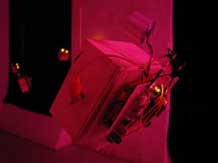Evolving Sonic Environment aims to record and review the history of a society of sonic devices distributed in a room. It is hoped that the collective behaviours of the devices will be affected by the way that the room is occupied (by people or other mobile objects) and, as such, the room will develop a “perception” of its occupancy. The society of devices together function as a kind of “people sensor”, though there are no “people sensing” functions built into the individual devices.


Drawing on the work of Gordon Pask, Donald Hebb and Andrew Adamatzky, the project investigates how one might construct an interactive environment that builds up an internal representation of its occupants through a network of autonomous but communicative sensors.
The devices function like simple neurons, cascading during high activity, altering their thresholds during periods of low activity and becoming apparently “bored” by repetitive inputs. Inputs and outputs consist of high frequency sound near the upper limit of human hearing. The devices are constructed chiefly from analog components and therefore are not “programmed” in the conventional sense to exhibit particular properties. When they have received sufficient input energy they themselves “fire”, with a continuous sound of varying frequency.
By Usman Haque and Robert Davis, Goldsmiths College.
Check it out at Threshold ’06, E:vent, London, as part of node.london. Opening Fri 24 Mar (6-10pm).
Via Flavorpill.
